Introduction
In today’s digital age, access to technology has become a pivotal determinant of individuals’ ability to receive and engage with healthcare services. However, a glaring issue known as the Digital Divide presents a significant challenge to this digital integration. This divide, referring to the disparity between individuals, households, or geographic areas in terms of access to information and communication technology, profoundly impacts healthcare delivery and access.
The Extent of the Digital Divide
The digital divide is not just about having or not having access to the internet. It delineates disparities in accessing healthcare technologies, digital literacy, and the capability to utilize technology effectively for health-related needs. This gulf is often most deeply felt by certain demographics- older people, individuals in rural areas, and those within lower socio-economic groups stand out as particularly vulnerable.
Recent studies have shown that these groups often lack basic internet services or digital devices, hindering their ability to take advantage of telehealth services and electronic health records, digital health applications, and other web-based health information resources.
Impacts on Health and Wellbeing
The digital divide creates significant health disparities, particularly in an age where telemedicine has become the norm due to the global pandemic. Individuals who lack access to digital technologies can miss out on basic care and timely medical advice, resulting in delayed diagnosis and treatment of illnesses.
Moreover, the proliferation of health information online has not benefited these communities due to limited digital literacy skills. This means they could be missing out on critical health and wellness information and self-care strategies.
Addressing the Digital Divide
The solution to this digital divide lies in increasing technology access, improving digital literacy, and creating tailored health information technology solutions for these marginalized groups. This would involve concerted efforts from all stakeholders: government, healthcare providers, private entities, and communities.
Increasing Access
Universal and affordable broadband access is the first step in reducing this divide. Government initiatives and partnerships with private entities can ensure rural and low-income urban areas are not left out of the technology revolution.
Improving Digital Literacy
Beyond access, building digital literacy is key to empowering individuals to navigate and use health information technologies effectively. This could be achieved through community-based training programs and collaboration with community healthcare professionals.
Tailored Health IT Solutions
Creating and promoting user-friendly, accessible health IT solutions targeting underserved populations ensures that health technology truly meets their needs. This approach includes designing telehealth platforms with easy-to-understand interfaces, utilizing local languages, and ensuring compatibility with low-cost devices.
Conclusion
Despite the challenges, the digital divide in healthcare presents an opportunity to build a more inclusive digital health landscape. With targeted initiatives focused on increasing access to technology, improving digital skills, and developing tailored health IT solutions, we can hope to bridge the gap and drive equitable healthcare delivery for all.

